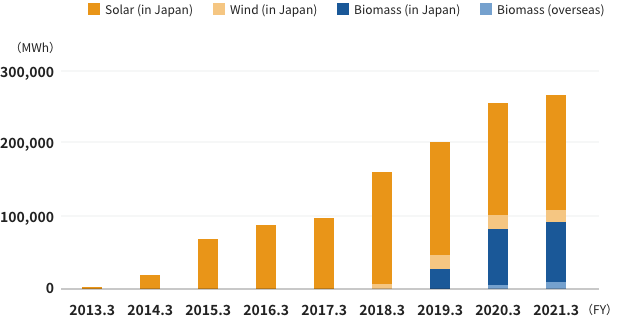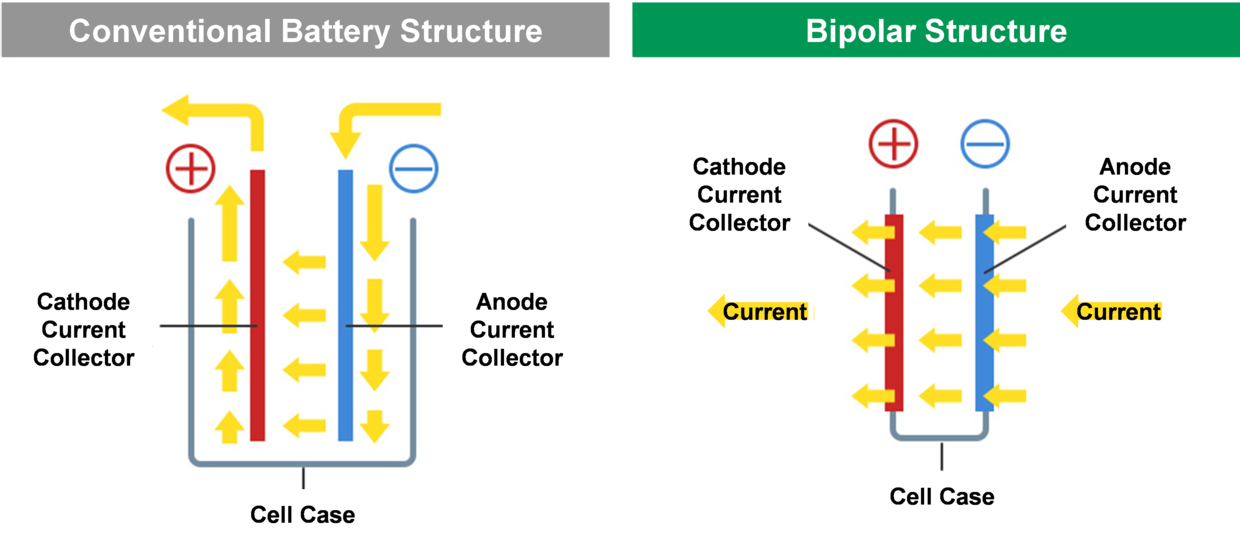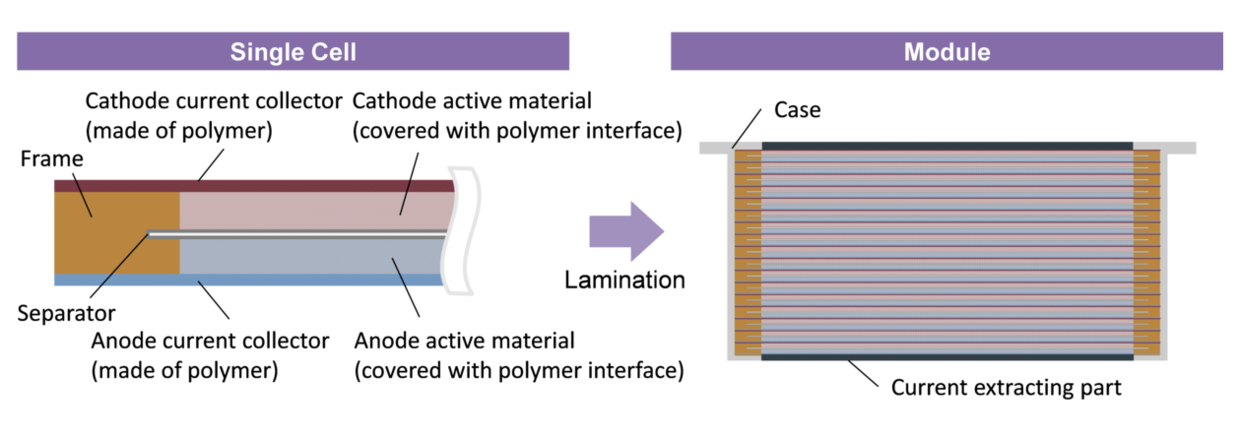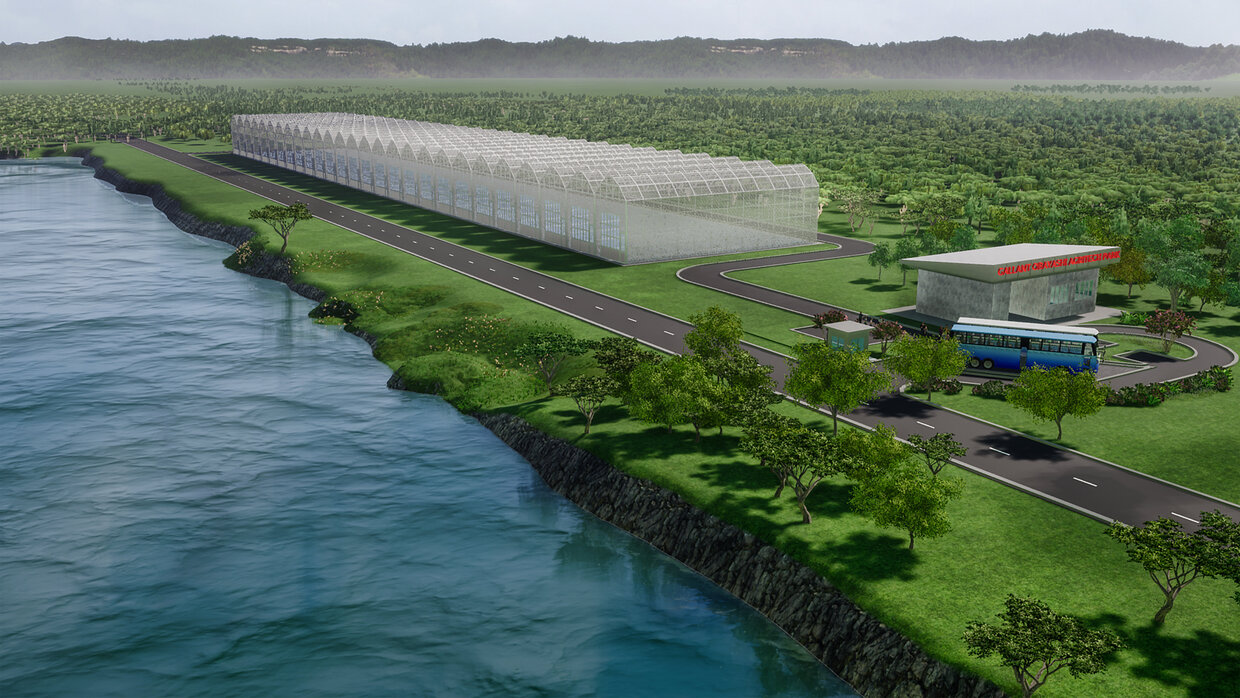Deepening and Expanding Business Domains (4) New Businesses
Expansion of the Renewable Energy Business
In the renewable energy business sector, Obayashi Corporation began commercially operating a woody biomass power plant in December 2018, along with promoting plans for offshore wind power generation and further striving to diversify its energy source portfolio by entering the fields of small-scale hydropower and geothermal power generation. These projects were undertaken in addition to the company’s already fully operational solar power and onshore wind power generation operations.
As of March 2021, the company’s renewable energy generation business is operating a number of facilities with a total capacity to generate about 154 megawatts (28 solar power plants: 133 MW; 1 wind power plant: 6 MW; 1 biomass power plant: 15 MW), which is enough electricity to power 70,000 Japanese households for a year.

In April 2019, construction began on the Obayashi Kamisu Biomass Power Plant in the city of Kamisu, Ibaraki Prefecture, which would become the second biomass power plant developed by the Obayashi Group. Scheduled to start commercial operations in October 2021, the power plant will be the first woody biomass power generation business to exclusively burn imported biomass. Responsible for its operation will be the Obayashi Kamisu Biomass Power Generation Corporation, which was established by the Obayashi Clean Energy Corporation. The main fuel will be wood pellets that have been third-party certified for sustainability, with palm kernel shells discarded in the palm oil pressing process also used. The plant’s power generation capacity is 51.5 megawatts, which is roughly equivalent to the annual electricity consumption of 110,000 households.
In September 2020, construction began on the Kamikita Ogawara Onshore Wind Power Plant in the village of Rokkasho, Aomori Prefecture. This was Obayashi Group’s second onshore wind power generation project. The company plans to use the Wind Lift construction method in the same way as it did for the Mitanehamada Wind Power Station. Once complete, operations are scheduled to commence at the end of FY2022.3. The plant’s power generation capacity is 20.4 megawatts (3.4 MW per turbine across 6 turbines), which is enough electricity to power about 17,000 households for a year.
Meanwhile, in the offshore wind power generation business, the company is undertaking a joint venture project at the ports of Akita and Noshiro, with an aim to start operations in FY2023.3. In March 2016, it was announced that a development feasibility study would be launched for Akita Prefecture; more particularly, the cities of Noshiro and Oga and the town of Mitane. The project was the first bottom-fixed offshore wind power project in Japan for which developers were selected by public tender. Preparations to commercialize the project are ongoing following the establishment of the Northern Akita Offshore Wind Farm Project LLC in July 2019.
The Act on Special Measures Concerning Procurement of Electricity from Renewable Energy Sources by Electricity Utilities came into effect in July 2012, bringing attention to small-scale hydropower generation as a renewable energy source capable of providing a stable supply of electricity. Accordingly, the company began working on small-scale hydropower generation (output of 1,000 kW or less). It is aiming to generate a total of 10 megawatts of power from sites including Nikko Ashio Small-Scale Hydroelectric Power in Tochigi Prefecture.
Finally, in the area of geothermal power, the company is working to generate geothermal power in the Northern Kyogoku and Rusutsu areas of Hokkaido. In addition, in July 2020, the company installed a pilot plant for producing CO2-free hydrogen using geothermal power in the town of Kokonoe, Kusu District, Oita Prefecture, which is the first of its kind in Japan. Field tests are being carried out in preparation for actual operations.
Growth of the PPP Business
Within the domestic PPP business sector, Obayashi Corporation focused on winning orders for new projects by cooperating with individual branches and Group companies. This was during the promotion of concession agreements alongside conventional private finance initiatives (PFIs) by the Japanese government, as well as an increase in orders from local governments. As a result, net sales generated by the 31 PFI subsidiaries increased significantly, from 22.5 billion yen in FY2016.3 to 47.4 billion yen in FY2020.3, as did operating income.
At the same time, there has been an increase in the number of PFI projects for which only maintenance management and operations are being undertaken, since the contract period of the original projects operated by the company has come to an end. For such projects, Obayashi Facilities Corporation is acting as the representative company and has formed a team to handle these operations.
The Obayashi Group aimed to increase earnings across the entire Group by further strengthening initiatives for the PPP business.
One major project during this period was the PFI-based design, construction and operation of the Osaka National Government Office Building No. 6, which was awarded to the company in November 2017. The project involves consolidating the Kinki Regional Development Bureau, Kinki Regional Police Bureau, Kinki Regional Administrative Evaluation Bureau, Osaka Legal Affairs Bureau, Osaka Public Security Intelligence Bureau, and West Japan Civil Aviation Bureau, all of which were dispersed across the city of Osaka and in various states of deterioration, as well as create a central facility for disaster response activities. The company was entrusted with design and construction, maintenance management, operations, and separate accounting systems (cafeteria, kiosk, and vending machine operation). In March 2018, the company was contracted for the Minoh Semba Station Area Urban Development Center Facility Construction and Operation Project (provisional name). Following the extension of the Kita-Osaka Kyuko Line, the company was tasked with constructing a cultural hall, lifelong learning center, library, underground parking lot, and adjoining facilities, such as cafes, in front of the new station to be built. The PFI project also comprises operation and maintenance of the cultural hall, underground parking lot, and adjoining facilities on an independent accounting basis.
The company also won the tender for the Kyoto City Waterworks and Sewerage Bureau’s Southern Branch Development Project in November 2019 (scheduled to begin service in May 2022). The plan was to build a new government building to serve as the business and disaster prevention center of the Kyoto City Water Supply and Sewage Bureau for the southern area of Kyoto, with the basic design completed in June 2020. Then, in January 2020, the company won the tender for the New Aomori Prefectural General Sports Park New Swimming Pool (& Other Facilities) Construction and Operation Project. This plan involved building a 50-meter indoor pool inside the New Aomori Prefectural General Sports Park ahead of the Aomori National Sports Festival in 2025, with the prefecture aiming to open the pool in April 2024.
Creation of New Business Models Using Storage Batteries
In March 2020, Obayashi Corporation invested in APB Corporation, a startup that is developing next-generation bipolar lithium-ion batteries called All-Polymer Batteries, and worked on creating new business models that utilize storage batteries.
Unlike conventional lithium-ion batteries, where the current flows parallel to the electrodes, the All-Polymer Battery has a bipolar structure in which the current flows perpendicular to the thickness direction of the electrodes. This structure allows the adoption of polymer current collectors, which have a higher electrical resistance than their metal counterparts, for the material of the positive and negative electrodes, thereby increasing reliability under abnormal conditions. Since the battery cells can also be stacked directly on top of each other and connected in a series, it is possible to reduce the number of parts in the battery and simplify the manufacturing process from that of conventional lithium-ion batteries. The All-Polymer Battery is further characterized by its unprecedented high energy density, as well as the endless possibilities in terms of increasing the size of cells and freely changing their shape.


The company’s investment in APB Corporation was the first of its kind for a construction company. Moving forward in its aim to create new business models, the company will make use of the All-Polymer Battery’s high degree of reliability under abnormal conditions and the additional characteristics above in installing storage batteries in buildings using novel methods, stabilizing the supply of renewable energy sources that were previously considered unstable, such as solar and wind power, and introducing these energy sources into Smart Cities and microgrids.
Initiatives to Expand New Businesses
Green energy is the fusion of energy alternatives such as renewable energy, hydrogen, and smart grids. It is becoming increasingly important in achieving carbon neutrality, one of society’s major challenges.
Under these circumstances, Obayashi Corporation reorganized its Technology Business Development Division and newly established the Green Energy Division in April 2021 as a way of bringing together the technology and expertise of the entire Group, as well as push forward with providing energy solutions to customers.
The goal for the Green Energy Division is to create revenue-generating opportunities from the entire green energy value chain. Utilizing the expertise amassed through the company’s renewable energy generation business and its capacity to supply a diverse range of energies, the division is working to promote its businesses. Meanwhile, it is making plans to commercialize new businesses that embrace next-generation technologies, such as electric power storage and hydrogen production/storage.
In addition, the PPP business was made independent from the division previously in charge of the PPP business and other new businesses, the Technology Business Development Division, with the PPP Division newly set up to further promote PPPs. Meanwhile, the Open Innovation Promotion Unit (part of the Corporate Strategy Division’s Corporate Business Innovation & Management Foundation Department) and the New Business Promotion Unit (part of the Technology Business Development Division) were integrated to form the Business Innovation Division. This was done to allow an exploration into other new business areas, demonstrating their viability to potentially realize their commercialization. In tandem with this change, the company reorganized the Corporate Strategy Division’s Corporate Business Innovation & Management Foundation Department, establishing the Market Intelligence Department as a department for collecting and analyzing data on the external environment, including policies and market needs.
Large-Scale Hydroponic Cultivation Using Advanced Greenhouses in Indonesia
Obayashi Corporation signed a Joint Development Agreement with PT. Persada Hijau Cemerlang (Indonesia), a subsidiary of Gallant Venture Ltd. (Singapore), with the goals of realizing the large-scale cultivation of cherry tomatoes and leafy vegetables using advanced greenhouses adapted to tropical climates and establishing a distribution and sales network for the products.
While the plan was suspended, then revised, due to the impact of the COVID-19 pandemic, demonstration testing to verify the project’s business potential is still in the works: first is a trial cultivation on Indonesia’s Batam Island from May 2021, and next is trialing sales in Singapore in August of the same year.
Through this field testing, the company is building on its expertise in large-scale hydroponic cultivation acquired from operating the greenhouse at the Group-owned Oak Katori Farm (Katori City, Chiba Prefecture), which was opened in November 2014. This knowledge is being combined with proprietary technologies, such as temperature control using air conditioning, to achieve a high level of control over the environment in the advanced greenhouse, with the aim of providing a large and stable supply of high-quality crops.
Across the Southeast Asia region, recent economic growth has led to rising incomes and increasing levels of health consciousness among the populace, which in turn has led to a higher level of interest in safe, high-quality food products. This field testing has not only allowed the company to establish a distribution infrastructure and channels for the Southeast Asia region, but also facilitates considerations into the potential of large-scale business development, with investigations into the marketability of the products among the target market of middle- and upper-income earners in the region and the development of distributors being carried out.
